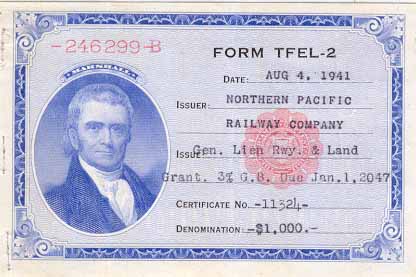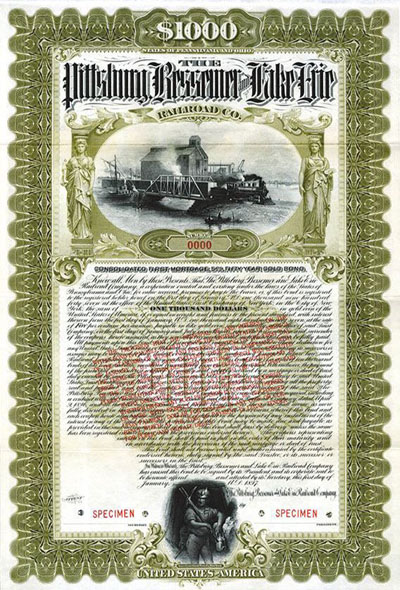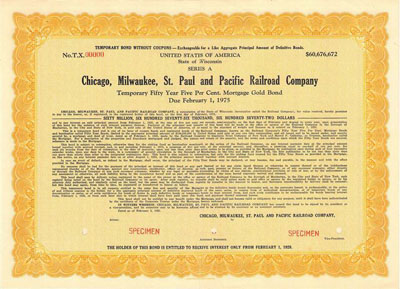Obscure bond features
A curious note about the text on bonds
Artisans etched and engraved text on steel plates with the same precision they dedicated to vignettes. Some engravers specialized exclusively in lettering. Their engraving was almost flawless. However, you will notice that almost all bonds engraved by the American Bank Note Company are hard to read.
There are two reasons for this difficulty. First, most text was engraved in script style. Script is substantially harder to read than ordinary 'Roman' or "block" letters.

Secondly, look closely and you will notice that engravers almost never crossed their lower case 't's. A reason for this strange tradition does not seem to have appeared in print.
American Bank Note Company was the main proponent of this style of engraved script. My earliest high-resolution image proves that ABN was using this style as early as 1860. However, I am unable to confirm that the style evolved from earlier predecessor companies.
I found sparse examples of this practice among certificates engraved by Snyder, but the use of non-crossed Ts seems inconsistent. For example, initial Ts were often crossed, while Ts embedded elsewhere in words ("interest" for example) were uncrossed. Please contact me if you can suggest a good reason for this strange habit.
Form TFEL-2
This small certificate bears a U.S. Treasury Department Seal and is sporadically found attached to bonds (and occasionally stocks). All encountered so far date have been dated 1941, 1942, and 1943.

Correspondent Neal Greenberg found reference to these documents at Presidential Advisory Commission on Holocaust Assets in the United States. One of those pages explains the issues involved in freezing assets of Germany and its conquered nations during World War II. The U.S. attempted to prevent hostile interests from trading securities and thereby funding war efforts. Of course, that action also inadvertently blocked trading by some victims from those same countries.
TFEL-2 was a form that allowed friendly, non-hostile foreign nationals to trade American securities during the war. Quoting Chapter III in the above reference, TFEL-2, was attached to securities "if the owners could prove that they were free from any blocked interest." The Treasury Department addressed many of these problems through certification, an expedient somewhat similar to the European practice of affixing tax stamps to legitimately acquired securities.
Form TFEL-2 was attached to securities, but was not a security itself. This project consequently ignores TFEL-2 as special scripophily documents.
Autographs
Many collectors collect autographs of rail-related celebrities and they are typically found on bonds in three roles and three different places.
Company officers
Only a limited number of autographs of company presidents are considered valuable. Practically all can be found on the bottom fronts of both stocks and bonds, usually adjacent to the issue date. These signatures have the highest probability of being cancelled when compared to the other signature types.
Bond holders
Bearer bonds did NOT require proof of ownership, so signatures of celebrities as bondholders on bearer bonds are rare. Conversely, registered bonds were registered to specific people and celebrity signatures appear very sporadically on the backs of registered bonds. Although most bearer bonds allowed conversion from bearer status to registered status, signatures of celebrities rarely appear on converted bonds, but when they do, they are normally untouched by cancellation.
Trustees
Famous rail-related celebrities frequently took on the roles of trustees for large bond and their signatures frequently appear on the back panels of bonds. One of the most common and prominent signatures is that of Henry Clews who signed about a thousand bonds of the Blue Ridge Railroad. John Pierpont Morgan signatures appear on the backs of many New Jersey Junction bonds and his signature is usually quite bold and presentable. Augustus Schell was another popular trustee signer although relatively few sellers mention his signatures.
Trustee signatures may or may not be cancelled, depending on where their signatures were placed and whether certificates were cancelled or not. If buying bonds supposedly adorned with celebrity autographs, collectors are advised to check with sellers prior to purchase. Ask them whether signatures were cancelled or not. Just because bonds were cancelled does not mean signatures were necessarily damaged.
Overprints

Red and blue overprints are relatively common on bonds, although few collectors pay much attention to their purposes. Such overprints were normally printed at angles to the underlying text which makes both the original text and the overprints difficult to read.
Overprints commonly changed terms of the original bonds, either by extending the periods of repayment or decreasing original interest rates. A small number, primarily specimens, are known with overprints that attest that redemptions of pre-1933 gold bonds would be in lawful money. These kinds of bond overprints are known as "Gold Clause" overprints. (See Gold bonds and frauds for deeper discussions of gold bonds and the abrogation of gold payment stipulations on ALL U.S. contracts after June 5, 1933.)
The image at right shows a large red overprint printed on an 1897 Pittsburg Bessemer & Lake Erie 50-yr gold bond. The overprint served notice to bond holders that henceforth, interest payments and bond redemptions were payable in lawful money, not gold coin. (Image courtesy Archives International Auctions.)
Atypical denominations
The vast, vast majority of bonds you see in this project are $1,000 bonds. Companies, of course, tried almost every conceivable denomination at one time or another including predictable variations such as $0, $100, $250, $500, $5,000, $10,000, $25,000 and $50,000. However, there are a few oddball denominations, mostly known in specimen form only. Among them are denominations such as:
- $140
- $158.33
- $5,250
- $1,488,000
- $1,545,000
- $1,800,000

High-denomination bonds are popular collectibles, but they appear for sale very, very infrequently. Collectors are advised not to play the cheapskate game when going after high-and oddball-denomination bonds. You will lose. The highest ten denominations seen so far include:
- $8,000,000
- $9,544,000
- $10,000,000
- $14,518,000
- $24,400,000
- $25,000,000
- $29,400,000
- $39,930,000
- $42,110,000
- $60,676,672 (shown at right)